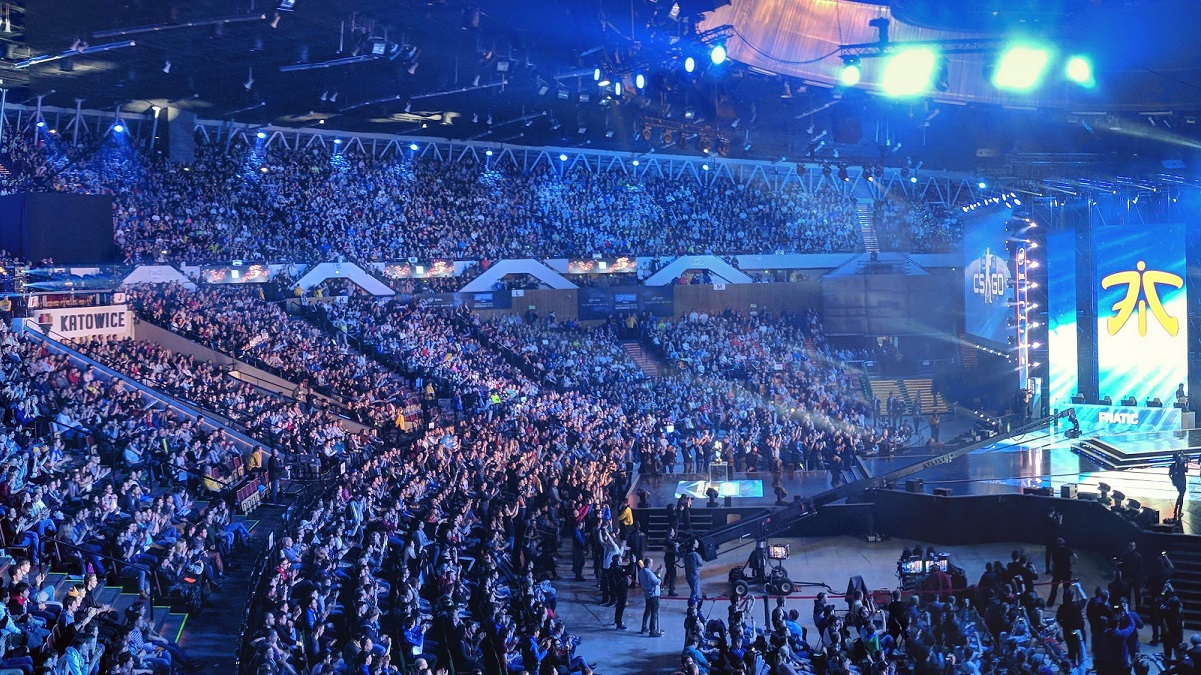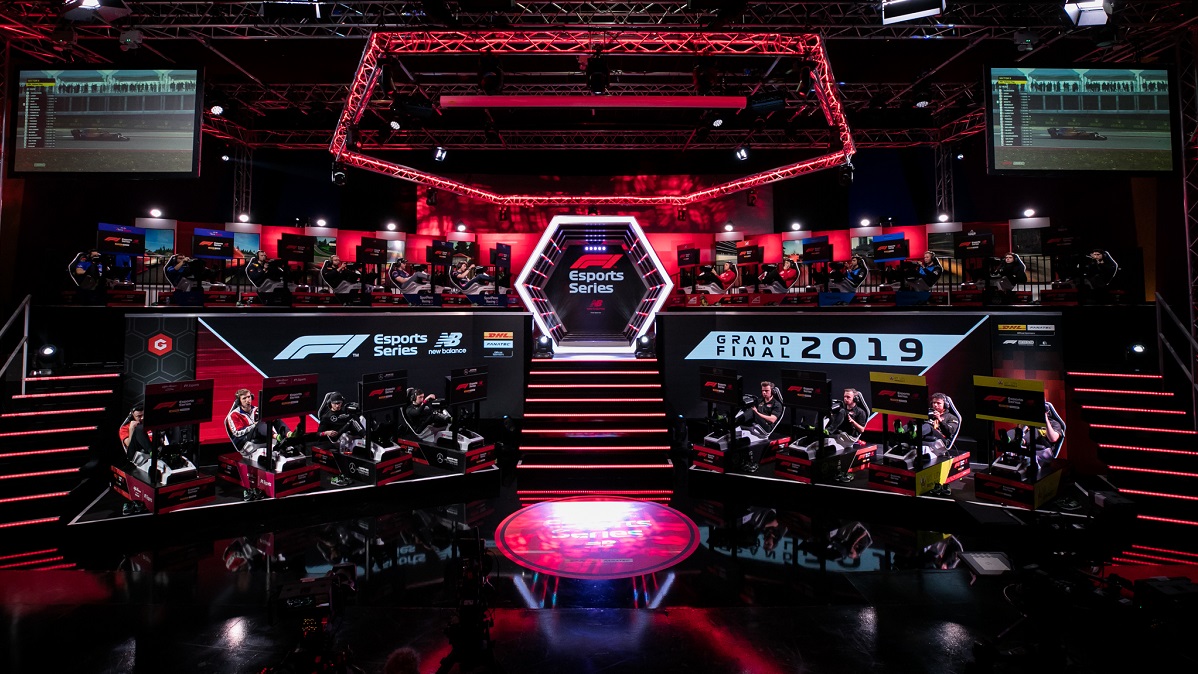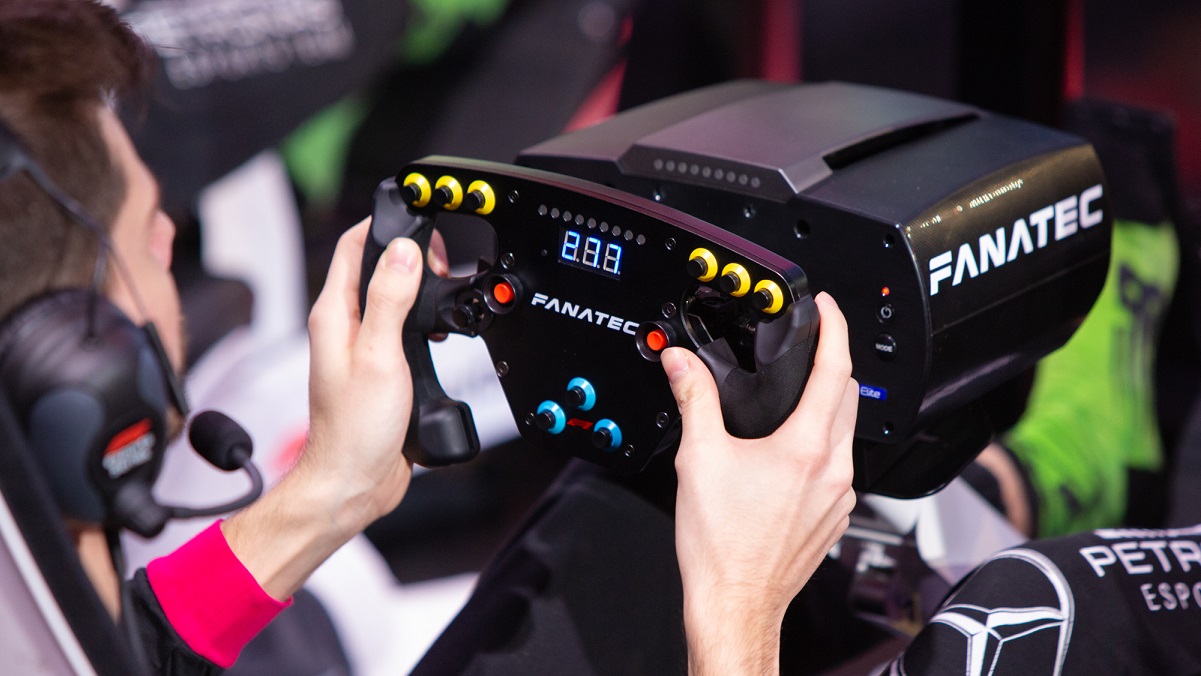The pandemic will change how we watch sports
The roar inside a packed stadium is felt more than heard, a kind of whole-body buzz. As the announcer on the PA brings the crowd to a crescendo, techno music pumping and lights strafing our heads, distant figures file onto the stage, sit in front of keyboards and PC screens, and fit helicopter-grade headphones over their ears to shut out the sound of 10,000 people chanting their names.
Two years ago I traveled to Katowice, Poland, to make a short video documentary about e-sports. The city's massive Spodek arena hosts some of the largest professional gaming events in the world, including the Intel Extreme Masters world championships for first-person shooter Counter-Strike and high-speed strategy game StarCraft. IEM 2018 was the biggest yet, with a million-dollar prize pot and around 100,000 fans turning up to cheer on their favorite teams.
This year, those teams played in silence. On February 23, with covid-19 cases popping up across Europe, Katowice's local government pulled the plug half a day before the event began. Players could compete, but without a live audience. To see it empty was utterly heartbreaking," says Michal Blicharz, vice president of pro gaming at ESL, the world's largest e-sports organization, which puts on the Spodek events.
IEM 2020 was one of the first large sporting events to be hit by covid-19. Hundreds of others have been canceled since. For top athletes in the Premier League, NFL, NBA, NHL, and more, this meant sitting out most of the season at home. But if your home has an internet connection, you can still play video games.
 The Intel Extreme Masters e-sports championships draw huge live crowds.WILL DOUGLAS HEAVEN
The Intel Extreme Masters e-sports championships draw huge live crowds.WILL DOUGLAS HEAVENThe last three months have seen the biggest crossover ever between mainstream sports and e-sports. Teams and promoters have been filling their suddenly empty schedules with video-game versions of their sports, keeping both fans and sponsors happy. Broadcasters such as Sky Sports, Fox Sports, and ESPN have shown hours of e-sports coverage, including football and soccer stars playing football and soccer sims Madden and FIFA. Formula One has run an entire season of grands prix using its officially licensed video game. And in Australia, NRL teams went head to head in Fortnite rather than rugby. Suddenly, among all the noise of competitive entertainment, we were the only ones," says Blicharz.
But with mainstream sports such as Premier League soccer now back on TV, what's next for e-sports? Has this time in the limelight been enough for it to break through? Possibly, but not in its usual form. If e-sports has a prime-time future, it might be one that draws as much on Celebrity MasterChef as on hard-core gaming.
Back to basicsWhen lockdowns were enforced, e-sports were quicker to adapt than their mainstream cousins. Despite the upheaval, putting on a virtual event was more a step backwards than a total redesign, as it would be for most mainstream sports. Video games like Counter-Strike became stadium fillers only in the last decade. Before that, e-sports matches all took place on the internet-and qualifying rounds for tournaments often still do. Taking things back 10 years wasn't such a huge shock-we were still able to operate," says Blicharz.
For real sports teams, adjusting wasn't quite so easy-although some were better prepared than others. A handful of teams have been dabbling in e-sports for a while. The Dallas Cowboys have a large e-sports center, for example. In Europe, the Premier League puts on a season of FIFA matches alongside its main fixtures. The Football Federation in Australia runs a similar e-sports league.
But it was motorsports that was best prepared and quickest to react. The FIA (Federation Internationale de l'Automobile, or International Automobile Federation), which is the international governing body for many motorsports from drag racing to Formula One,has been investing in e-sports for several years: Formula One has run a championship for its officially licensed video game since 2017.
This previous experience meant that when live events were pulled, Formula One, Formula E, IndyCar, and NASCAR were quick to plug the holes with video-game versions.
 The Formula One Esports Series has been running since 2017 .GFINITY
The Formula One Esports Series has been running since 2017 .GFINITYThe 2020 virtual grand prix was put together from scratch in five days, says Paul Kent, head of e-sports and competitive gaming at Gfinity, a UK firm that puts on e-sports events and worked with Formula One on this year's races. In what was pitched as a charity event, celebrities and stars from other sports were invited to race alongside drivers from Formula One's e-sports and mainstream rosters.
The first challenge was shipping more than a dozen large simulation rigs to participants across Europe, just as transport hubs were shutting down. Rather than video-game controllers, Formula One e-sports use cockpit-size simulators. These were sent out in flight cases containing chassis, seat, steering wheel, foot pedals-not to mention powerful PC and large screen.
But it was even harder to find good webcams, which participants would use to give viewers a passenger-seat view of the at-home action. We must have searched every building in the whole of London to get a webcam so that Liam Payne from One Direction could race," says Kent.
In other cases, championships were launched with less forethought. Without an existing licensed video game to use, Formula One's electric offshoot Formula E began an eight-week virtual season with only two tracks that were reused for the first five weeks, in wet conditions and then dry. They hadn't quite realized how big a job it was to make more of them," says Hazel Southwell, a motorsports journalist and e-sports fan.
Big advantageMotorsports have one obvious, big advantage over other sports in these times, though. Take soccer: playing as a digital Messi in FIFA is nothing like playing as Messi, says Kent. Goals in a real stadium take more than a flick of a joystick and tap of a button. Racing sims, on the other hand, are hyper-realistic facsimiles of the real thing.
In racing simulators, tracks are typically scanned using lasers. The developers analyze every single bump and curve, right down to the millimeter," says Kent. Players with simulation rigs control their vehicles with wheels and pedals. They take corners at speed and avoid other cars; they manage their fuel and tires. You don't have the same G forces, but to an audience what competitors are doing is really quite similar," says Southwell.
In fact, the racing sims are so good Formula One teams use simulations to test vehicle designs. A few gamers have even graduated from video game to track. The Formula One team McLaren runs an annual video-game tournament called World's Fastest Gamer in which the winner has a chance to work on McLaren's simulation team, fine-tuning its cars.
 Drivers use simulation rigs to compete in virtual races and to fine-tune cars.GFINITY
Drivers use simulation rigs to compete in virtual races and to fine-tune cars.GFINITYGT Academy, a reality-TV competition run by Nissan and Sony, in which gamers raced against each other in the PlayStation game Gran Turismo, has also produced a handful of real racing drivers. One of the most high-profile winners, British driver Jann Mardenborough, who beat 90,000 other people to win the competition in 2011, is still racing for Nissan in the Japanese Super GT Series.
Still, when real races were shut down in March, several Formula One drivers needed to be cajoled into playing. Athletes are competitive, whatever the sport, and some were concerned that they wouldn't be able to drive fast enough in the game. Yet by the end of the season, George Russell, a Formula One driver for Williams, came within a second of being one of the world's best e-sports drivers. With sims so realistic, real-world driving skills can win you virtual races too.
Among the various e-sports events that teams cobbled together in lockdown, the Formula One events were a highlight. But they were still a poor substitute for genuine competition.
On top of that, home internet connections were often not up to it. You had drivers in places as far apart as Brazil and New Zealand, so the delays were through the roof," says Southwell. By the time they saw the starting lights go out, everyone else had already crashed." Southwell had to stop watching.
But organizers have learned quickly. Last weekend, racing fans were treated to a 24-hour virtual Le Mans event in which each team was required to include a mix of Formula One e-sports racers and Formula One drivers. The teams also had time to train together, which made the event genuinely thrilling, says Southwell. It was such a success that there are already plans to hold a virtual Le Mans again next year, whether or not we are in lockdown.
But will the wider e-sports boom last? Blicharz doesn't think these games are a threat to the Premier League or NBA. If for the last 30 years you've been watching Liverpool or Arsenal every weekend you're not going to suddenly stop when the Premier League resumes," he says. But it's probably accelerated the social acceptance by a decade."
Kent agrees: We've had a trapped audience," he says. If you'd asked parents in January if they'd spend Sunday night watching video games with their kids, chances are they'd have said no. But with nothing else on offer, many have.
Popular entertainmentWhat they're watching isn't quite the e-sports you might get inside Spodek arena or on the game-streaming site Twitch, however. And that's deliberate. If you stick pure, hard-core e-sports in front of people, you wouldn't engage with a wide audience," says Kent. To do that we tweak the product to make it popular entertainment."
Gfinity says that a record-breaking 30 million people watched its Formula One races during lockdown. On the back of that success, Gfinity is pushing a new type of event: part sport, part e-sport, and part celebrity reality show. That's one reason the last-minute webcam dash before the virtual grand prix was essential. Relaxing the rules and easing up on the competitive culture of both sports and e-sports lets you have more fun, says Kent.
Even Blicharz thinks that e-sports should lighten up a bit. When I asked him for a highlight of the last few months, he didn't pick a memorable win or point to surging viewer numbers. He told me about the time a commentator in the studio was caught crawling back to his seat, trying to avoid the camera, wearing bright yellow Crocs.
This goofiness introduces an intimacy that e-sports has lost, he says. When ESL scrambled in the early weeks of lockdown, they broadcast first-person shooter game Counter-Strike from their office in Cologne, Germany, instead of a big stadium or slick studio. Forced to wing it, they found a new authenticity. We were so fixated on having such a beautiful, perfectly crafted show that we forgot to have a sense of humor in it," says Blicharz. Our audience appreciates silly things."
Typically, conventional sports and e-sports have had very little to do with one another. But when stadiums closed, the two worlds found themselves overlapping in unprecedented ways. As they move apart again, each is taking something away from the experience. E-sports has found a goofier, more family-friendly entertainment format. Meanwhile, the traditional sports world has learned about putting on virtual events and discovered that cheap tech like webcams can provide extra intimacy.
The short-lived crossover between the two worlds is already beginning to unpick itself. Southwell says Twitch accounts that visiting sports fans made to watch e-sports are starting to go dormant. Does that matter? In many ways, e-sports is doing fine, with or without mainstream backing. It's a billion-dollar industry in its own right, after all.
And yet real sports teams, promoters, and broadcasters are always looking for new ways to attract fans and sponsors. If they have learned nothing from the crossover of the last three months, it's a wasted opportunity, says Southwell: It would be stupid if people just scoot back to the real world and leave behind all these abandoned Twitch accounts, like a strange ghost stadium sitting around on the internet."